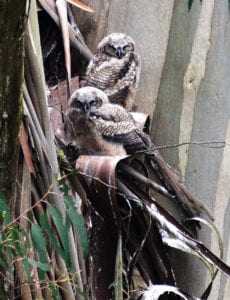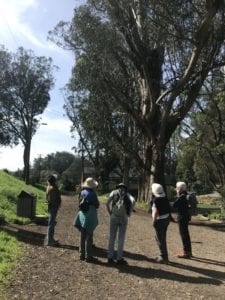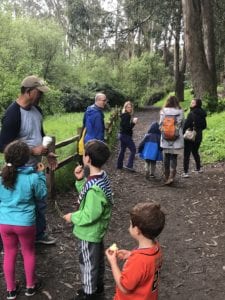
The missing great horned owls have returned!
A eucalyptus tree only yards from the Recreation Center has once again become a wooded refuge to a great horned owl family. Their return comes three years after Glen Canyon’s resident owls disappeared.
On March 16, 2016 a distant relative was found dead on a trail just west of the creek, a victim of rat poison. Either from homes or from businesses, San Franciscans continue using bait boxes. Owls consume rodents that have entered and left such traps and then die from the poison.
The corpse of the healthy great horn owl female was transferred to the California Department of Fish and Wildlife and a necropsy was performed.
A preliminary report was issued on March 23, 2016 which found the bird’s death was consistent with anticoagulant rodenticide toxicosis.
But after a break of three seasons, an adult pair and their two chicks have once again taken up residence in the park.
Their nest is made of leafy eucalyptus duff, fronted by a lengthy bib of bark.
Recently the two juveniles recently posed for photos from eager birders, their yellow eyes halos, their ear tufts white to buff.
Ignoring the onlookers, each spent time grooming one another. Secure in their bower, they swiveled their necks at obtuse angles. As adults, such torques make startling 180 degrees turns.

The two infants extricated themselves from braids of branches their parents had woven. They were two fluffs of fur, white in color, decidedly visible, carpeted in a blanket of leaves that did little to disguise their scruffy and mottled down.
Reaching adulthood, the duo’s soft and sooty fledged feathers will keep each warm, allowing each to fly silently, better to perfect stealth-like predation upon rabbits, gophers, skunks, even crows, ravens and hawks. With their powerful talons, hoot owls can sever the spine of larger mammals, taking 28 pounds of pressure to relinquish their grasp.
As eager birders watched, the siblings roosted and snuggled, the bigger of the two more conspicuous as its tiny ears, the shape of the Transamerica building, stood at attention.
The raptors’ parents were out and about, possibly hunting morsels for the ravenous sibs. At their tender age, each owlet is capable of downing up to five or six rodents an evening, and at the age of nine to 10 weeks are capable of leaving the nest and hunting for themselves.

In a month or two they’d be on their own, ready to take flight, establishing their own arboretum domesticity throughout the City.
The most widely distributed owl in America, the nocturnal great horned owl is perfectly at home in Glen Canyon, replete with habitats of woodland interspersed with California native grasses.
Now, until the baby owls fly off, they are a neighborhood draw.
Such was the case on a recent day when a group of children from Chenery and Randall Street’s Dolores Huerta Elementary (once known as Fairmont) accompanied by their teacher, Helena Young, milled up trail from the owl tree that was only a few feet from where the poisoned female was found in 2016.
Young was puzzled as to where the owl tree could be found.
She approached two walkers, both of whom had left the owl tree only minutes earlier.
“We heard the baby owls are back,” said Young. “The students dissected owl pellets in class. Can you tell us where we can find the owls?”
Photographs of the owls were shared; then directions provided.
Helena Young quickly herded the children, then trooped off.
Over her shoulder she called, “Isn’t it wonderful learning about the wonders of the City.”